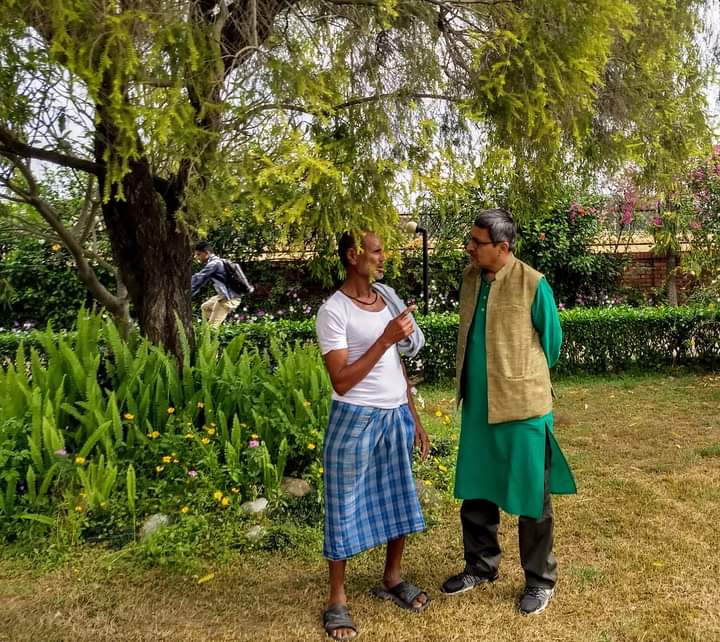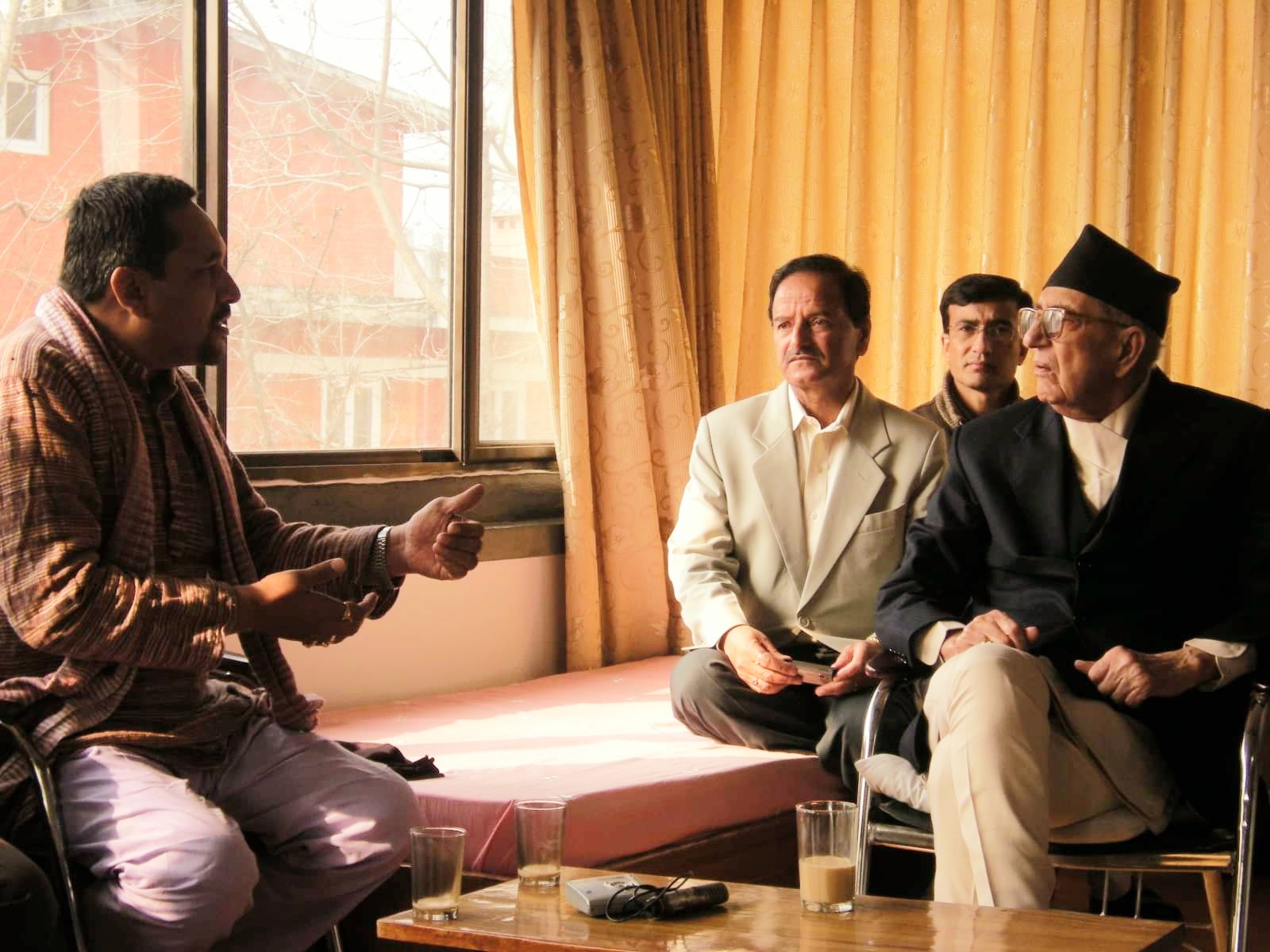
Writing journeys
11 MIN READ

This week in Writing Journeys, journalist and storyteller Chandrakishor writes about the value of learning new languages and using writing as a tool for social harmony.

Like many of our contributors, Chandrakishore has long shown a love of storytelling. “Since my early days,” the Sarlahi-born, Birgunj-based journalist writes, “I had a strange but natural habit of narrating anything I experienced.” As a boy, he liked to explore the weekly bazaar and report on his wondrous discoveries: “earthen pots, carpets of jute, and curious wooden items.” All became material for letters to his grandfather.
In this essay, we hear from a storyteller from Nepal's eastern and central lowlands. We hear about the influences on his life: his uncle's books, his grandmother's stories, Bhawani Prasad Ghimire, a handwritten tri-lingual homegrown newspaper, his teacher Balkrishna Saras sir, the Indian journalist Ganesh Shankar Vidyarthi, and even a Tarai buffalo or two.
Chandrakishore ji shows a deep commitment to Nepal's lowland Tarai region and to seeking out, understanding, and documenting the meanings that reside far outside of Kathmandu's Ring Road. “I felt that the issues and concerns of this area,” he writes, “needed to be amplified through writing.” He displays a profound appreciation of Nepal's marvelous cultural diversity and for the dignity of ordinary people. A love of languages goes with that, and of local phrases and proverbs as a window on to different worldviews. His father wanted him to be a doctor. Lucky for us, Chandrakishore stayed a storyteller.
Chandrakishore ji offers a quick warning that caught my eye — “just visiting different places won’t yield much.” In a world where it seems Nepalis and everyone else is moving around more and more, I also worry about the driveby analysis Chandrakishore dislikes. Of course, travel is good but in addition to the social media photo ops, I wish I'd also hear about the stereotype-breaking conversations people have with locals and the myth-busting articles and novels they read that explain the story behind the photos — exactly the kind of careful, informed, place-based nonfiction writing that Chandrakishore stands for.
Chandrakishore is a prominent journalist, based in the central border town of Birgunj. He writes on media, politics, and society for Himal Khabarpatrika and Kantipur Daily and other national publications. He is chairperson of the Centre for Investigative Journalism-Nepal. Some of his recent articles include ‘Chaubata ma Madhes’ (Madhes at a crossroads, Kantipur, July 8) and ‘Madhesi rajneeti ko akaar’ (The shape of Madhesi politics, Kantipur, June 17). Also see Pranaya Rana, ‘Chandra Kishore: The Madhesi agenda is a national agenda,’ The Kathmandu Post, December 28, 2019.
Writing Journeys appears each Wednesday. In previous weeks, Shradha Ghale described “eloquent talkers”, Kunda Dixit wrote about “showing off”, Niranjan Kunwar on the “confusing universe”, Kesang Tseten on “people revealing”, Sujeev Shakya on the “target audience”, Kalpana Jha on “simple language”, Janak Raj Sapkota on “hidden corners”, Dipak Gyawali on “flabby verbosity”, and Manjushree Thapa on “unhappy months”. (No flabby verbosity around here!) In an earlier week, I described four useful skills and last week, I explained why I decided to organize this series on writing.
Next week: Sanjay Upadhya
Since my early days, I had a strange but natural habit of narrating anything I experienced. If I visited a mela in my village, I would come home and share everything with my mother. In the shanichare bazaar (every Saturday), I would discover curd sold in earthen pots, carpets of jute, and curious wooden items, which were all new for me. Likewise, going to see the Mechi river, the border between India and Nepal, was a unique experience for me. All such experiences would find place in my conversations and even the letters that I wrote to my grandfather. My family members appreciated my ability to articulate daily experiences and present them in an interesting manner.
This love of storytelling, which I sharpened over time, helped me both in journalism and writing. In the art of writing, sharing characters and events with the audience is an extremely important ability.
My first tryst with literature took place when my father was posted in Bhadrapur, Jhapa, as a government officer in public health. We lived in a flat owned by renowned Nepali writer Bhawani Prasad Ghimire. Since my early childhood, I was drawn to stories told by my grandmother and other elders. I would spend most of my time reading or listening to short children’s stories. Bhawani ji learned about my keen interest in stories. He called me and requested that I narrate the Maithili folk stories of Gonu Jha. He heard seven stories from me that day and, in return, offered me a few candies.

During my stay in Bhanunagar in Bhadrapur, I realized that some people spoke different languages. I learned about Nepal's language diversity and the coexistence of its people. Bhanunagar had Rajbansi, Santhal, Bengali, Nepali, and Tharu speakers.
In secondary school, I participated in poem recitations, elocution competitions, and debates. I even used to write poems myself. My high school Nepali teacher, Balkrishna Saras sir, would give feedback on my writings. He inspired me to read literature and encouraged me to share my work with others.
Once, before my matriculation exams, I went home to Balara in Sarlahi for summer vacation. While at home, I was assigned to take the cattle to graze in the evening. One such evening, I discovered my badka kaka’s (eldest uncle’s) book collection. I borrowed a book and took the buffalo to the fields. I sat on the buffalo’s back and had enough space to place my book in front of me to read comfortably. Those buffalo rides were quite enjoyable. I didn’t have to do much. I would just sit and read so many books while the buffalo kept grazing.
The first book I read from my uncle’s collection changed my life. It was a Hindi book that discussed journalism: What is journalism? Who is an ethical and honest journalist? It explained how to start a handwritten newspaper and how to amplify voices of the marginalized. This idea struck a chord with me, especially since the book also spoke about the life and work of renowned Indian journalist Ganesh Shankar Vidyarthi who contributed a lot to building social harmony and empowering marginalized communities through journalism. This was the first time I desired to become a journalist, even though my father wanted me to pursue medical studies.
I grew up during Nepal's Panchayat Raj. In Sarlahi, after graduation, my friends and I started an organization called the Gram Uthaan Parishad to develop our village. We started our own handwritten newspaper, Gram. It was a semi-annual, trilingual (Bajjika, Nepali, and Hindi) newspaper. I was the editor. This venture brought light to my childhood dream of becoming a journalist, though it was just an amateur beginning. Gradually, after graduation, I ventured into professional journalism.
Since I am from a marginalized Madhesi community that lives near the border, I felt that the issues and concerns of these areas needed to be amplified through writing, and the right way to do it was to live someplace other than Kathmandu. I selected Birgunj, a southern border town, as my karmabhoomi.
I write mostly in Nepali but I like to mix in a lot of Tarai vocabulary. To give perspective to Tarai issues, I use words from Bajjika, Bhojpuri, Maithili, or Awadhi and also highlight Tarai proverbs, which reflect a community’s culture, wisdom, and perspective.
On the other hand, even though Nepali is not my mother tongue, if I read something good in Nepali and like a word, I try to make it my own. I feel the gates for new vocabulary should always be left open. I believe in the samriddhi-vikas (development-evolution) of languages over shudhhata (purity).
At the same time, I believe there is no replacement to one’s own rich vocabulary. A journalist or a writer goes through an examination in front of their readers each time they write.
When I started out in Birgunj, I developed an interest in Nepali, Maithili, Bhojpuri, and Hindi. I believe that if one loves a language, one should respect all languages. Languages are a common yet distinct property of the world. Additionally, if you know multiple languages, you will be more skilled as a writer, because each language has its own mechanism and mode of expression.
I have initiated many literary movements for these languages and taken active part in them through my writings, meetings, and events. Amongst those are Prabhat Kabya Yatra, Sahitya Sandhya, Maithali Sahitya Parishad, and Nepal Bhojpuri Pratisthan. Most of these events and organizations were conceived in my house in Birgunj.

To those who wish to pursue writing and reading, and this applies to me as well, one has to do three things constantly. First, one has to observe their identity — it could be gender, class, caste, religion — and its interaction with the establishments, both social and political. Second, one has to observe the changes around them in all aspects — lifestyle, fashion, thinking, socio-political dynamics, linguistics, interpersonal relations, interactions between communities — and most important of all, the direction of these changes. Third, there are a lot of people who have written about identity and recent changes. So please find the areas that interest you and dive deep into the literature.
Another rich source of stories are the bhuin manchhe — the common people on the ground. Bhuin manchhe are living, walking stories. Their experiences and problems carry multiple stories in them. For example, if you study a person who migrates to another place in search of a job, which in itself is a rich story, you’ll find layers about the work opportunities available around his place, the state’s intervention in that region regarding unemployment, the economy of people in that geography, and much else. One person’s story is a reflection of a larger group's story.
If you talk to bhuin manchhe, you may come across a phrase, word, or a perspective that will give you an idea to write a bigger piece. That’s why I prefer to talk to them — I like their authenticity and diversity of stories.
But please understand that just visiting different places won’t yield much content if you don’t interact with people. For a good story, there have to be multiple perspectives to every observation. Interactions with people give us an opportunity to establish connections between the issue and its geography.
Finally, over time, I’ve realized that in my early writings, I was inclined towards difficult words, phrases, and expressions. But now, I prefer simple expressions, even for complex subjects, as I keep in mind the range of readership. The idea is to reach people with limited vocabulary as well.
Most importantly, I firmly believe that writing should promote social harmony and peace over provocative and violent expressions. This is a must for a diverse society’s evolution in the right direction.

Tom Robertson Tom Robertson, PhD, is an environmental historian who writes about Kathmandu and Nepali history. His Nepali-language video series on writing, 'Mitho Lekhai', is available on Youtube. His most recent article, 'No smoke without fire in Kathmandu’, appeared on March 5 in Nepali Times.


Writing journeys
30 min read
Or, why I love vigorous verbs and why you should too
Writing journeys
17 min read
As the old year comes to an end and a new one begins, we look back on a year of Writing Journeys, reflecting on the diverse stories we've read and the great advice we've received.
Writing journeys
7 min read
This week on Writing Journeys, the writer and consultant Sujeev Shakya talks about the importance of listening in writing.
Writing journeys
10 min read
Water expert Ajaya Dixit recounts his writing journey of learning to bridge the gap between the natural and social sciences.
Writing journeys
12 min read
In this edition of Writing Journeys, Tom Robertson shares hisown insights on learning to write well, especially during thislockdown.
Writing journeys
9 min read
Akhilesh Upadhyay details all he has learned in his 30 years of journalism and offers advice to both aspiring journalists and experienced ones who are stagnating.
Writing journeys
17 min read
This week on Writing Journeys, series editor Tom Robertson identifies 20 common mistakes Nepalis make in English and how to avoid them.
Writing journeys
12 min read
This week on Writing Journeys, engineer and political economist Dipak Gyawali pays tribute to the teachers who taught him to write precisely and meticulously.